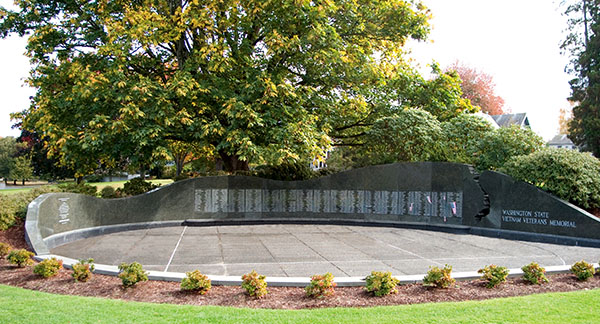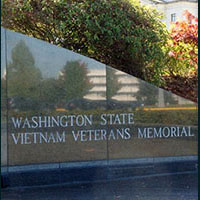— by Lin McNulty, Managing Editor —
 They came one by one and their common denominator was camouflage. They camouflaged themselves behind beards, long hair, sunglasses, and an attitude. They shoved their white-knuckled fists deep into the pockets of their green field jackets and hunched their shoulders against the cold, the rain, and the pain. They came out of curiosity and some degree of inexpressible hope about recognition, but approached in suspicion and mistrust.
They came one by one and their common denominator was camouflage. They camouflaged themselves behind beards, long hair, sunglasses, and an attitude. They shoved their white-knuckled fists deep into the pockets of their green field jackets and hunched their shoulders against the cold, the rain, and the pain. They came out of curiosity and some degree of inexpressible hope about recognition, but approached in suspicion and mistrust.
It was Veterans Day 1982, and the State of Washington was dedicating a Vietnam Memorial in Olympia. The national Vietnam Wall was also being dedicated that day.
One by one they chose a spot in the crowd of about 300 spilling over following the ceremony at the nearby twelve-foot Winged Victory statue perched atop a towering WWI monument which has been the annual gathering place to pay tribute to the veterans of the “big wars” since 1938.
Each man tried to find a safe spot where he could have a view of his perimeter, cautious of anyone who might approach and especially wary of the government officials who stood to the front of the small gathering preparing to speak of remembrance and service to country. They carefully skirted the older veterans of previous wars who were uniformly visible in their vests and overseas caps heavy with patches and pins from the VFW or American Legion.
The newspapers later reported that they stood shoulder to shoulder, but they did not allow themselves that degree of closeness—not on this day. They had not stood shoulder to shoulder since leaving their foxholes, one by one, and landing 24 hours later in San Francisco—some as long as 15 years prior. Although they were careful to avoid much more than a brief glance or nod of the head to acknowledge each other’s presence, they each silently recognized who they were and where they had been.
The monument was a cold marble block, the size of a rock one might excavate from the backyard in order to make room for something green to grow. When Governor John Spellman stepped forward to insert a scroll listing the names listing the 1,001 names of Vietnam War casualties from Washington into this vault, permanently sealing the names in stone away from public view, the grating scratch of rock on rock set in motion a five-year battle against the State government.
Over the next five years, a group of veterans lobbied, marched, and went public with their displeasure that names of those who sacrificed were not publicly visible on this new monument. A yearly all-night vigil was held on the Capitol Campus every Veterans Day where the names were read aloud.
Eventually, $178,000 needed to construct a new memorial was raised through private contributions and corporate donations, and a beautiful new Vietnam Veterans Memorial was constructed. Designed by Kris Snider, architect with EDAW, Inc. of Seattle, it is a semicircular wall that stretches partially around a 45-foot base on a rolling course, seven feet tall at the apex, one foot at its lowest point. The top of the wall represents the highs and lows of the life of the nation until it is interrupted by a jagged line in the outline of Vietnam, symbolizing the break in the circle of life caused by the conflict. The new monument was dedicated on Memorial Day, May 25, 1987.
Buried beneath that Wall, placed carefully in a midnight raid by Vietnam Veterans of the construction site, is the name of Governor John Spellman.
**If you are reading theOrcasonian for free, thank your fellow islanders. If you would like to support theOrcasonian CLICK HERE to set your modestly-priced, voluntary subscription. Otherwise, no worries; we’re happy to share with you.**








